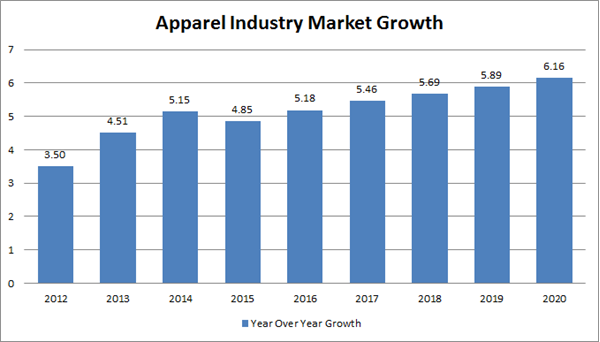I own 10 black t-shirts. Three from Gap, four from H&M, one from Buffalo and two from Gilden. When it comes to blue t-shirts I have at least 5, I probably have 3 grey tees, maybe 3 in white, and I even have 2 yellow t-shirts (don’t ask). The crazy thing is that all of this is still not the entirety of my solid colored tee collection. With the count up to 23, we still haven’t discussed how many red, pink, or green tees I own. We have yet to even touch graphic t-shirts, let alone polos, button-downs, and full sleeves. Hell, we haven’t even talked about pants yet.
The apparel market is growing faster than the global economy.
Let me tell you up front, I have clothing for all occasions, from weddings to lounging with friends. I have enough clothes for everything that comes my way. Realistically, if I periodically wash and ration properly, I would not need new apparel for at least a decade. Yet none of this stops me from shopping.
The only reason I’m never deterred from my desire to consume is that I perceive my behavior to be relatively normal. I don’t feel like I’m shopping alone in my favorite stores – actually, it feels as if I am always waiting in lines. In my mind, I like to think that everyone around me is out shopping too. Who can resist a good deal? Two for one? I’ll take six! Shopping is something that gives me a ton of confidence. When I look good, I feel good.
None the less, I recognize that my wardrobe is a bit excessive (Narnia could be hiding behind it). All of this has made me think about clothes a lot lately, specifically how clothing is consumed. Am I really normal in the way I make purchases or do other people do it differently? I decided to look at the facts.
How Much Do We Love Clothes?
My grandmother has only one shirt in her wardrobe. My mother has three. My daughter’s generation, 50. And 48% of them, she never wears. — Jack Ma, Founder and Executive Chairman of Alibaba Group
Apparel industry’s market growth (post-2017 figures are projected).
According to MarketLine, a business information company, the global apparel industry has been growing at a 4.78% yearly rate since 2011. Now valued at nearly 1.4 trillion dollars in sales for 2017, the industry shows no signs of slowing as the market is projected to experience 5.91% yearly growth over the next three years.
By 2020, the market size of the apparel industry is expected to reach a mind-boggling 1.65 trillion sales in US dollars worldwide. I was shocked when I discovered this as it amounts to a whopping 60% increase in the market size since the 1.05 trillion dollar pool in 2011.
Apparel industry market size (post-2017 figures are projected).
Simply put, this rapid growth means that the average consumer in the world is now buying more than 1.5 times the amount of apparel they did just 6 years ago. (If that doesn’t knock your socks off, I don’t know what will.)
To give you some enhanced perspective, the Worldbank claims that the growth in global GDP from 2011 to 2015 meets an average rate of 2.70%. If we compare the growth of clothing consumption from that period, which MarketLine stipulates to be 4.50%, with the 2.70% average growth in global income, we clearly see something happening: Each year we are more than proportionately increasing the amount of money we spend on clothing.
All figures come from MarketLine.
Statistically then, it’s clear that people have a greater interest in shopping than they have had in previous years. Which means that my consumption of clothing, though undoubtedly expansive, really isn’t that insane of a deviation from the norm.













Leave A Comment